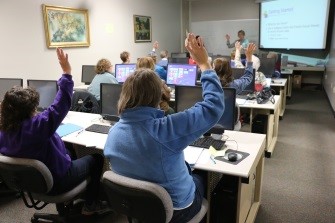Protecting Your Students When Reading: Textbooks & Trade, Large Print or Braille Books

When students use…
- a book such as a textbook, trade, large print or braille book
- on a table or desk
- a typical chair
Sitting at a desk reading textbooks, reading books, large print or braille books should follow the same posture guidelines as sitting at a desk using a laptop, desk top computer or an iPad.

- Start by seating your student close to this position.
- Use foot support if needed or a high/low chair or desk; to obtain…
- foot support close to 90/90 at knee/hip
- elbow support at the level of the desk height
Reading with your eyes
Visually reading a book at a desk often results in the student leaning over to see the print since most often, books are placed flat on the desk’s surface. Depending on the height difference between the desk and the student’s head, they may just have to bend at the neck or find themselves having to lean their torso forward. Thus, this poor posture when reading can get worse as your students get taller.
Students also can be seen supporting themselves by using their elbows, their arms or even lying their heads down to attempt to relieve the discomfort of having to sit at the desk and read a book.
When a student tires of leaning forward, they often – if able – hold the book upright and read for a while. Only to go back to placing it back on the desk when their hands and arms tire.
Reading with your hands
This hunched-over position can also be seen by students who read braille.
In addition, the height difference of a student’s shoulders to the desk often makes it difficult to read braille. As you can see in the picture on the right, the student is not properly positioned; the mid-arms are leaning on the edge of the desk while the elbows are out to the side. Not only is this type of seating not protecting a student’s body over time but it also does not follow basic guidelines on positioning for reading braille.
(See Observation list ‘Good skills in reading Braille’.)
Potential solutions
Providing a better reading position is so very important. Below are some suggetions to keep your student’s head and trunk upright, without leaning forward.
Seating tips. Sometimes inclining the seat of the chair in a downwards direction, so that it opens the seat angle, will promote trunk extension. In other words, it may encourage the trunk to be more upright. This may be helpful if a student usually rounds their back with their head forward. You could try a rolled towel on the seat or even thin blocks under the back two chair legs.
Use a bookstand with adjustable height. As we have looked at before in previous blogs, using various bookstands to elevate a student’s reading material would be helpful. This helps students who are visual readers to position books at eye level.
Elevate the desktop at an angle. Providing desktops that raise to offer an angled reading surface may also be useful. This would enable students to not only sit up straighter but to have arm support while holding a book. For those reading braille, a slight angle just might feel a bit more relaxed.
Add better lighting. Lighting is extremely important when reading. Research show that lighting affects affects academic achievement, attention rates, working speed, productivity and accuracy. Some students need more lightening and some need reduced lightening yet most of the lighting found in classrooms is overhead fluorescent lighting. Its important to see if lighting is a factor in your student’s reading performance and make some personal adjustments. Below are some options of many for direct light.
Remember… your decisions and planning
will protect students when reading books at their desk.
AIM-VA provides educators a way to have books converted to accessible files for students who have an Individualized Education Program (IEP). Search for books through the AIM-VA website. Books not currently found in the AIM-VA library, can be produced if requested by an AIM-VA DRM (Digital Rights Manager) in any Virginia public school division.


















